Over one billion euro has been invested in the wellness and spa industry in Bulgaria over the past more...
| Search | Hotels / Accommodation | Vacations | Tours & Trips | Rent A Car | Transport | Flights | Conferences | Press Centre | Yachting |
- Hotels & Accommodation in Sofia





- Anel Hotel
- Arena di Serdica
- Grand Hotel Sofia
- Hilton hotel
- Holiday Inn Sofia

- Kempinski - Zografski Hotel
- Radisson Blu Grand hotel
- Sheraton Hotel Balkan




- Best Western Plus Bristol Hotel
- Sofia Princess Hotel
- Anastasia Residence
- Art'Otel hotel
- Berlin Park Vitosha Hotel
- Best Western Europe hotel
- Best Western Hotel Expo
- Best Western Plus City Hotel
- Best Western Premier Thracia
- Casa Boyana Boutique Hotel
- Central Hotel Forum

- Central Park Hotel
- Crystal Palace Hotel
- Festa Hotel Sofia
- Geneva hotel
- Gloria Palace hotel
- Hill Hotel
- Les Fleurs Hotel
- Maria Louisa Hotel
- Maxi Park Hotel & Spa
- Metropolitan Hotel Sofia

- Park Inn Sofia
- Rodina hotel
- Silver House Hotel
- Sofia Residence Boutique Hotel
- Sveta Sofia hotel
- Triada hotel
- Tsarsko Selo hotel
- Vega Hotel
- Vitosha Park Hotel



- Accord Hotel

- Apartment House Dunav
- Aris Hotel
- Arte Hotel
- Atlantic hotel
- Bon Voyage Hotel Alexander
- Budapest Hotel
- Bulgari Boutique Hotel

- City Avenue Hotel
- Elate Plaza Hotel
- Fashion Hotel
- Gorublyansko Hanche
- Hemus Hotel
- Kolikovski Hotel
- Latinka Hotel
- Legends Business Hotel
- Lion hotel

- Lozenetz Hotel
- Maxim Hotel

- Meg-Lozenetz hotel
- Niky hotel
- Park Hotel Moskva
- Renaissance Hotel
- Scotty’s Boutique Hotel
- Slavyanska Beseda hotel
- Sofia Place Hotel
- Vitosha Tulip Hotel


- Arte Apartment House
- ATM Centre Hotel
- Brod hotel
- Eleganza Hotel
- Medik Hotel

- easyHotel Sofia
- Lavele Hostel
- Nearby hotels



- AIR SOFIA GOLF CLUB - IHTIMAN
- Diplomat Holiday Village
- Sofia Guide
- Early booking in Sofia
- All inclusive in Sofia
- Last minute in Sofia
- Hotels in Sofia
- Apartments in Sofia
- Villas in Sofia
- Rural houses in Sofia
- Vacations in Sofia
- Transport To Sofia
- Tours in Sofia
- Conferences in Sofia
- Articles on Sofia
- News From Sofia
- Map of Sofia
- Restaurants in Sofia
- Sofia City Tour
- Rila Monastery
- Dragalevtsi Monastery
- Biking in Vitosha
- Vitosha Mountain
- Dragoman swamp
- Sofia Airport
- Sofia WiFi Zones
- Holidays in Bulgaria
- All inclusive
- Beach
- Birdwatching
- Golf
- Health
- History
- Hunting
- Monasteries/ Religious
- Mountain biking
- Prom
- Rural
- Ski
- Spa & Wellness
- Trekking
- Water sports
- Weekend breaks
- Wine
- Conference
- Children Holidays
- Yachting
- Events
- Type of accommodation
- Hotels
- Apartments
- Villas
- Rural houses
- Destinations
- Aheloy
- Ahtopol
- Albena
- Apriltsi
- Arbanassi
- Asparuhovo
- Assenovgrad
- Bachkovo Monastery
- Balchik
- Bankya
- Bansko
- Banya (Karlovo)
- Banya (Razlog)
- Batak
- Beklemeto
- Belchin Bani
- Beli Iskar
- Belogradchik
- Berkovitsa
- Blagoevgrad
- Bodrost
- Bojichen
- Borovets
- Botevgrad
- Bourgas
- Bozhentsi
- Bratsigovo
- Brestovitsa
- Buzludja
- Byala
- Chepelare
- Cherepish Monastery
- Chernomorets
- Chiflik
- Devin
- Dimitrovgrad
- Dobarsko
- Dobrich
- Dobrinishte
- Dolna Banya
- Dospat
- Dryanovo
- Dupnitsa
- Dyuni
- Elena
- Elenite
- Elhovo
- Gabrovo
- Gela
- Golden Sands
- Gorna Oryahovitsa
- Gotse Delchev
- Govedartsi
- Grand Hotel Varna
- Harmanli
- Haskovo
- Haskovo Mineral Baths
- Hissarya
- Ivaylovgrad
- Kalofer
- Kamchia
- Kamen Bryag
- Kardjali
- Karlovo
- Kavarna
- Kazanlak
- Kiten
- Kom
- Koprivshtitsa
- Kosharitsa
- Kostenets
- Kostenkovtsi
- Kotel
- Kovatchevitsa
- Kranevo
- Kresna
- Kulinoto
- Kyustendil
- Lom
- Lovech
- Lozenets
- Lukovit
- Lyaskovets
- Madara
- Malko Tarnovo
- Malyovitsa
- Melnik
- Mezdra
- Momchilovtsi
- Montana
- Narechen Baths
- Near Golden Sands
- Nessebar
- Obzor
- Ognyanovo
- Osogovo
- Pamporovo
- Panagyurishte
- Panichishte
- Parshevitsa
- Pavel Banya
- Pavlikeni
- Pazardjik
- Pernik
- Petrich
- Pirdop
- Pleven
- Pliska
- Plovdiv
- Pomorie
- Pravets
- Preslav
- Primorsko
- Ravda
- Razgrad
- Razlog
- Ribaritsa
- Rila Monastery
- Riviera
- Rousse
- Rusalka
- Samokov
- Sandanski
- Sapareva Banya
- Semkovo
- Sevlievo
- Shabla
- Shipka
- Shipkovo
- Shiroka Laka
- Shkorpilovtsi
- Shoumen
- Silistra
- Sinemorets
- Sliven
- Smolyan
- Sofia
- Sopot
- Sozopol
- Srebarna
- St. Constantine & Elena
- Stara Zagora
- Starozagorski Baths
- Sunny Beach
- Sunny Day
- Sveti Vlas
- Svilengrad
- Svishtov
- Targovishte
- Teteven
- Tran
- Trigrad
- Troyan
- Tryavna
- Tsarevo
- Tsigov Chark
- Uzana
- Varna
- Varshets
- Veliko Tarnovo
- Velingrad
- Vidin
- Vitosha
- Voneshta Voda
- Vratsa
- Vratsata Gorge
- Yagoda
- Yakoruda
- Yambol
- Zlatitsa
- Zlatograd
- Bulgaria Guide
- General information
- Bulgarian Monasteries
- SPA Bulgaria
- The Black sea
- History
- Geography
- Maps
- Weather
- Airports in Bulgaria
- Webcams
- Forums
- Mountains in Bulgaria
- The Balkan Mountain Range
- Rila Mountain
- Pirin Mountain
- The Rodope Mountain
- Vitosha Mountain
- Travel Arrangements
- Visit Bulgaria
- Visa Requierments
- Choose Destination
- Flights to Bulgaria
- Transport in Bulgaria
- Advice
- Currency
- Official Holidays
Subscribe to newsletters to receive our hottest offers:
| Home > Sofia |
Sofia
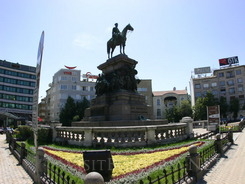
Location: Sofia is the capital city of Bulgaria and the heart of the country as well. The city is a cultural, administrative and industrial centre and its motto definitely deserves to be “It grows, but does not age”. Sofia is the biggest city in Bulgaria. It is surrounded by the Balkan Mountains Range to the north, the Lozen Mountain to the south-east, the Mountain Vitosha to the south and the Lyulin Mountain to the southwest.
It is at 550 meters above sea level. Pancherevo Lake and Iskar Dam are situated in close proximity to the capital city. Sofia is linked by international routes with the capitals of Europe, and through Istanbul and Ankara, with the Middle East.
Today Sofia is a modern European capital city with many business and trade centres, dynamic night life and cultural sightseeing attractions.
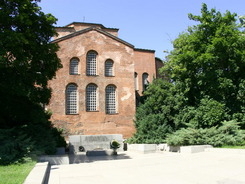 History: Sofia is a city with a 7000-year history, which makes it a unique phenomenon, dating back to most distant antiquity of Europe.
History: Sofia is a city with a 7000-year history, which makes it a unique phenomenon, dating back to most distant antiquity of Europe.
During the 8th century before the new era an ancient Thracian settlement, called Serdica was established. The first name of Sofia actually comes from it. It was given to the city by the Thracian tribe- Serdi. The reason why this land became a settlement is the presence of warm mineral waters, running through Sofia Plain at that time. Even nowadays healing water is running down from drinking fountains in the centre of the capital city.
At the time of the Roman Empire, the city of Sofia was the centre of the Roman Quarter, called Lower Dacia. Ancient towers, fortress walls, administrative and religious buildings were built then. Then the capital city was named Sredets, which means “middle, centre”, because its location is considered to be the Balkan Peninsula centre. Later on, Bulgarian lands fell under Byzantine rule and the city was renamed Triyaditsa, meaning “between mountains”. After the liberation of Bulgaria from Byzantine rule the capital city name was Sophia.
The St. Sophia Church, which stands to this day next to the St. Alexander Nevski Memorial Cathedral, gave the city its present-day name.
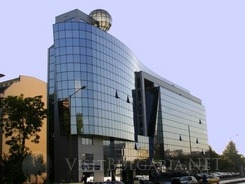 During that period Sofia started to develop as a European city. Schools and administrative buildings were built. System of sewers telegraphs and telephone network and railway and tram network.
During that period Sofia started to develop as a European city. Schools and administrative buildings were built. System of sewers telegraphs and telephone network and railway and tram network.
Nowadays Sofia is a very placid place to live in. It is now going through major changes with its huge construction of modern buildings. A brand new underground connects the city centre with the outskirts. There are plenty of luxurious hotels, traditional, native restaurants, shopping malls and many places for entertainment. A variety of modern business centres and shopping malls are being built along the big boulevards, like Tsarigradsko Shousse and Nikola Vaptsarov Blvd. The region of Todor Aleksandrov Blvd., where the geographic centre of Sofia is, comes up as an administrative complex and business park of the city.
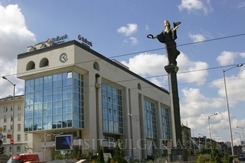 Sightseeing: At the crossroad of “Maria Luisa”, “Alexander Dondukov” and “Todor Aleksandrov” Boulevards the spectacular statue of Saint Sofia, symbol and patron of the city, is situated. Her golden face faces “Battenberg” Square, where the Central Department Store (TsUM), Sheraton Hotel Balkan, The Presidency of National Republic of Bulgaria and the Council of Ministers are situated. Close to the statue the Central Sofia Covered market “Hali”, the Mosque and the “St. Nedelia” Church are located as well. In the subway under the Saint Sofia statue is the entrance of “Serdika” metro station, which is actually the first stop, and also the ruins of “Saint Petka” Church. This area actually represents the cross point of the historical and the cultural appearance of the city, the business and the art face of the big and modern capital.
Sightseeing: At the crossroad of “Maria Luisa”, “Alexander Dondukov” and “Todor Aleksandrov” Boulevards the spectacular statue of Saint Sofia, symbol and patron of the city, is situated. Her golden face faces “Battenberg” Square, where the Central Department Store (TsUM), Sheraton Hotel Balkan, The Presidency of National Republic of Bulgaria and the Council of Ministers are situated. Close to the statue the Central Sofia Covered market “Hali”, the Mosque and the “St. Nedelia” Church are located as well. In the subway under the Saint Sofia statue is the entrance of “Serdika” metro station, which is actually the first stop, and also the ruins of “Saint Petka” Church. This area actually represents the cross point of the historical and the cultural appearance of the city, the business and the art face of the big and modern capital.
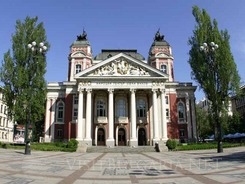 To see all landmarks of Sofia, one will surely need to have enough spare time. The city is the cultural centre of Bulgaria and has many museums, galleries and theatres worth to be visited. Some of them are the National Museum of History, the Bulgarian Natural History Museum, the Museum of Earth and Men, the Ethnographic Museum, the National Museum of Military History and the National Archaeological Museum. In addition, there are the Sofia City Art Gallery, the Bulgarian National Gallery of Arts, the Bulgarian National Gallery for Foreign Art, as well as numerous private art galleries. A real piece of art is the notable building of “Ivan Vazov” National Theatre, built in a German neoclassicism architecture style.The theatre was founded in 1904, and its building was completed in 1907. The hall is flanked by two balconies and there are 850 seats. The theatre employs some of the country's best actors and stage directors, enjoying popularity, not only in Bulgaria, but all over Europe. One of the central streets of Sofia, “Rakovski” St. is linked along with theatre buildings, including the Drama Theatre, the Theatre of the Army and “Salza i Smiah” Theatre.
To see all landmarks of Sofia, one will surely need to have enough spare time. The city is the cultural centre of Bulgaria and has many museums, galleries and theatres worth to be visited. Some of them are the National Museum of History, the Bulgarian Natural History Museum, the Museum of Earth and Men, the Ethnographic Museum, the National Museum of Military History and the National Archaeological Museum. In addition, there are the Sofia City Art Gallery, the Bulgarian National Gallery of Arts, the Bulgarian National Gallery for Foreign Art, as well as numerous private art galleries. A real piece of art is the notable building of “Ivan Vazov” National Theatre, built in a German neoclassicism architecture style.The theatre was founded in 1904, and its building was completed in 1907. The hall is flanked by two balconies and there are 850 seats. The theatre employs some of the country's best actors and stage directors, enjoying popularity, not only in Bulgaria, but all over Europe. One of the central streets of Sofia, “Rakovski” St. is linked along with theatre buildings, including the Drama Theatre, the Theatre of the Army and “Salza i Smiah” Theatre.
 St. Alexander Nevski Cathedral and Memorial Church is also one of the symbols of Sofia. The altar and the patriarch's throne are cut of multi-colored marble. The belfry of the church rises to a height of 50.52 meters. The central dome is gold-plated with a massive gold cross on top. The Crypt of the cathedral houses a collection of masterpieces of Bulgarian icon painting. Visitors can enjoy the exhibited more than 200 icons and frescos. A souvenir shop sells copies of some of the famous icons, post cards, albums and folders. Close to St. Alexander Nevski Cathedral and Memorial Church is the Russian Church of Saint Nikolai. . The pointed golden cross of the church is noticed from far away. The interior of the church contains wonderful orna¬ments and unique Russian-style icons. In this area the Bulgarian Academy of Science and the National Assembly are located as well. The edifice of the National Assembly (built in 1884) is the third rightful candidate for the city's emblem. A motto inscribed on its main facade reads "Union makes Strength" -a key element of the coat of arms of the Republic of Bulgaria. Opposite its building is the monument to the King Liberator of Bulgaria (inaugurated in 1905) - the Russian Tsar Alexander II.
St. Alexander Nevski Cathedral and Memorial Church is also one of the symbols of Sofia. The altar and the patriarch's throne are cut of multi-colored marble. The belfry of the church rises to a height of 50.52 meters. The central dome is gold-plated with a massive gold cross on top. The Crypt of the cathedral houses a collection of masterpieces of Bulgarian icon painting. Visitors can enjoy the exhibited more than 200 icons and frescos. A souvenir shop sells copies of some of the famous icons, post cards, albums and folders. Close to St. Alexander Nevski Cathedral and Memorial Church is the Russian Church of Saint Nikolai. . The pointed golden cross of the church is noticed from far away. The interior of the church contains wonderful orna¬ments and unique Russian-style icons. In this area the Bulgarian Academy of Science and the National Assembly are located as well. The edifice of the National Assembly (built in 1884) is the third rightful candidate for the city's emblem. A motto inscribed on its main facade reads "Union makes Strength" -a key element of the coat of arms of the Republic of Bulgaria. Opposite its building is the monument to the King Liberator of Bulgaria (inaugurated in 1905) - the Russian Tsar Alexander II.
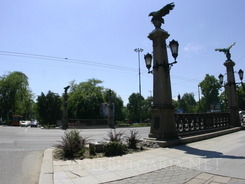 Sofia has beautiful bridges too. Luvov Most (the Lions' Bridge) over the Vladaiska River lies north of the city centre in the direc¬tion of the Central Railway Station. It has four lions statues placed on high pedestals. The other statues bridge is Orlov Most (the Ea¬gles' Bridge) over the Perlovska River. It lies in the beginning of “Tsarigradsko Chaussee” Boul¬evard and has four bronze eagles, which are facing the four direc¬tions of the world and are mounted on 12-metre pylons.
Sofia has beautiful bridges too. Luvov Most (the Lions' Bridge) over the Vladaiska River lies north of the city centre in the direc¬tion of the Central Railway Station. It has four lions statues placed on high pedestals. The other statues bridge is Orlov Most (the Ea¬gles' Bridge) over the Perlovska River. It lies in the beginning of “Tsarigradsko Chaussee” Boul¬evard and has four bronze eagles, which are facing the four direc¬tions of the world and are mounted on 12-metre pylons.
In Sofia one could also walk the streets Graf Ignatieff, Rakovski, and Vitosha Boulevard, where a variety of shops, luxury boutiques, cafes, restaurants and clubs are located. Another point of interest is the Slaveikov Square, where in front of the City Library the largest open-air book market of Sofia is arranged. An original bronze monument of two Bulgarian writers - father and son Petko and Pencho Slaveikov, in honour of whom the square is named after, were built. One can sit for a while on the bench next to them and have his photo taken.
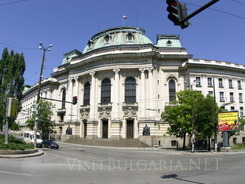 The cultural landmarks of Sofia are numerous. To the east of the Parliament building, across a small garden, the impressive building of St. Kliment Ohridski Sofia University rises. It is the first high school in Bulgaria, built in 1920 with personal donations by the brothers Georgievi, whose statues stand proudly at the parade entrance of the university. Across the street the National Library St. St. Kiril and Metodii is situated. In front of it is the monument of the two brothers, who created the Bulgarian alphabet and helped the literacy on the Bulgarian lands.
The cultural landmarks of Sofia are numerous. To the east of the Parliament building, across a small garden, the impressive building of St. Kliment Ohridski Sofia University rises. It is the first high school in Bulgaria, built in 1920 with personal donations by the brothers Georgievi, whose statues stand proudly at the parade entrance of the university. Across the street the National Library St. St. Kiril and Metodii is situated. In front of it is the monument of the two brothers, who created the Bulgarian alphabet and helped the literacy on the Bulgarian lands.
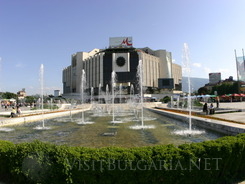 Another historical landmark is the Roman red brick rotunda, now being called St. George Church. It is situated in the inner yard of the Presidency, amid the remains of the ancient town of Serdica and that is why it is considered to be the oldest building in Sofia.
Another historical landmark is the Roman red brick rotunda, now being called St. George Church. It is situated in the inner yard of the Presidency, amid the remains of the ancient town of Serdica and that is why it is considered to be the oldest building in Sofia.
Definitely a favourite place for the residents of Sofia and also a meeting point is the National Palace of Culture. The building has a unique architecture design. It features 16 big halls, the largest one having 5000 seating capacity. A lot of fairs, presentations, concerts and public events are held there. During summer the fountains in front of the palace dance and create a lively joyful atmosphere. The place in front is also a favourite place of skaters, boarders and bikers, because of the many low stairs around the fountains.
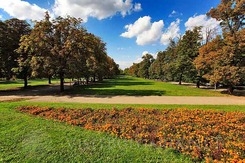 Green Areas: Being encircled by Vitosha Mountain and having plenty of parks in its centre, the capital city offers great places for relaxation and recreation amongst nature. Borissovata Gradina (the Garden of Boris) is in the centre of the city. At the very beginning of the park the Ariana Lake is located. Further in the park, the Vassil Levski National Stadium and Bulgarian Army Stadium, as well as courts and a cycle - racing track are found. In different residential quarters of the city Yuzhen Park, Zapaden Park, Severen Park, Geo Milev Park, and many other green parks are situated.
Green Areas: Being encircled by Vitosha Mountain and having plenty of parks in its centre, the capital city offers great places for relaxation and recreation amongst nature. Borissovata Gradina (the Garden of Boris) is in the centre of the city. At the very beginning of the park the Ariana Lake is located. Further in the park, the Vassil Levski National Stadium and Bulgarian Army Stadium, as well as courts and a cycle - racing track are found. In different residential quarters of the city Yuzhen Park, Zapaden Park, Severen Park, Geo Milev Park, and many other green parks are situated.
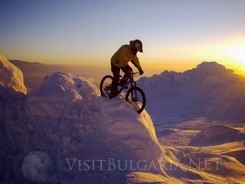 Vitosha Natural Park is a preferred place for tourism and relaxation, because its close proximity to the capital. There are ten peaks, which are over 2000 metres high. The highest one is Cherni Vruh (the Black Peak), which is at 2290 metres above sea level. In Vitosha Nature Park there are beautiful relicts of paraglacial forms, such as stone rivers, stone seas and talus and old snow peaks niches. The biggest tourist attraction of such type is Zlatnite Mostove (The Golden Bridges). The highest fall in Vitosha is Boyana Fall – the water falls from 40 meters. It is situated at 1300 m above sea level, in the Valley of Boyana River.
Vitosha Natural Park is a preferred place for tourism and relaxation, because its close proximity to the capital. There are ten peaks, which are over 2000 metres high. The highest one is Cherni Vruh (the Black Peak), which is at 2290 metres above sea level. In Vitosha Nature Park there are beautiful relicts of paraglacial forms, such as stone rivers, stone seas and talus and old snow peaks niches. The biggest tourist attraction of such type is Zlatnite Mostove (The Golden Bridges). The highest fall in Vitosha is Boyana Fall – the water falls from 40 meters. It is situated at 1300 m above sea level, in the Valley of Boyana River.
The mountain offers wonderful opportunities for trekking, ski, snowboarding, mountain biking, alpinism, paraplanerism, cave and speleological tourism.
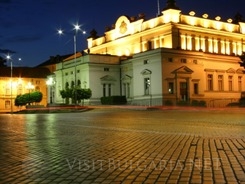 Wine and Dine: Regarding life and entertainment Sofia is definitely number one in Bulgaria. Here the visitors can really enjoy the night life and be non stop surprised. Some of the night clubs have gained the honour of being the most attractive ones in Europe. The restaurants and the bar & grill diners are numerous. Visitors can try traditional Bulgarian cuisine, and also taste dishes from the Japanese, Indian, European, and Latin American cuisine. There are very good luxurious 5 star hotels for the business travelers, also average nice and cosy hotels, offering appropriate accommodation facilities and services.
Wine and Dine: Regarding life and entertainment Sofia is definitely number one in Bulgaria. Here the visitors can really enjoy the night life and be non stop surprised. Some of the night clubs have gained the honour of being the most attractive ones in Europe. The restaurants and the bar & grill diners are numerous. Visitors can try traditional Bulgarian cuisine, and also taste dishes from the Japanese, Indian, European, and Latin American cuisine. There are very good luxurious 5 star hotels for the business travelers, also average nice and cosy hotels, offering appropriate accommodation facilities and services.
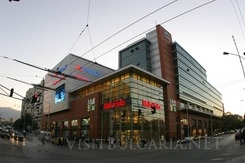 Shopping: As a modern capital city Sofia follows all the world up-to-date trends in trade business. A couple of new shopping malls – City Centre Sofia, Sofia Mall, Sky City Sofia - have recently opened doors to meet the eager consumers of luxury brands. Mall of Sofia disposes of the first 3D IMAX cinema on the Balkan Peninsula.The modern cinema halls leave precious moments and offer great cinema experiences. Sofia definitely has to show you a lot. It is one of the capitals, which should be visited for sure.
Shopping: As a modern capital city Sofia follows all the world up-to-date trends in trade business. A couple of new shopping malls – City Centre Sofia, Sofia Mall, Sky City Sofia - have recently opened doors to meet the eager consumers of luxury brands. Mall of Sofia disposes of the first 3D IMAX cinema on the Balkan Peninsula.The modern cinema halls leave precious moments and offer great cinema experiences. Sofia definitely has to show you a lot. It is one of the capitals, which should be visited for sure.
More resorts and destinations in Sofia region
-
 Bankya
Bankya is a small picturesque town, …
Bankya
Bankya is a small picturesque town, …
-
 Beli Iskar
Location: Beli Iskar village is …
Beli Iskar
Location: Beli Iskar village is …
-
 Borovets
General info: The oldest Bulgarian …
Borovets
General info: The oldest Bulgarian …
-
 Botevgrad
Location: Botevgrad is located 350 …
Botevgrad
Location: Botevgrad is located 350 …
-
 Dolna Banya
Location: Dolna Banya town is …
Dolna Banya
Location: Dolna Banya town is …
-
 Govedartsi
The village of Govedartsi is …
Govedartsi
The village of Govedartsi is …
-
 Koprivshtitsa
Koprivshtitsa is a small …
Koprivshtitsa
Koprivshtitsa is a small …
-
 Kostenets
Location: Kostenets is situated in …
Kostenets
Location: Kostenets is situated in …
-
 Malyovitsa
Malyovitsa is a small resort 40 …
Malyovitsa
Malyovitsa is a small resort 40 …
-
 Pirdop
Location: Pirdop is situated in …
Pirdop
Location: Pirdop is situated in …
-
 Pravets
Location: Pravets is a small town …
Pravets
Location: Pravets is a small town …
-
 Rila Monastery
The “St. Ivan Rilski” monastery is …
Rila Monastery
The “St. Ivan Rilski” monastery is …
-
 Samokov
Samokov is situated on the northern …
Samokov
Samokov is situated on the northern …
-
 Vitosha
General Info: 1800 m above sea …
Vitosha
General Info: 1800 m above sea …
-
 Zlatitsa
Location: The town of Zlatitsa is …
Zlatitsa
Location: The town of Zlatitsa is …


























